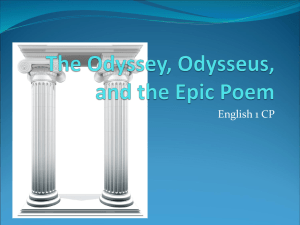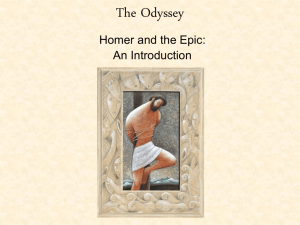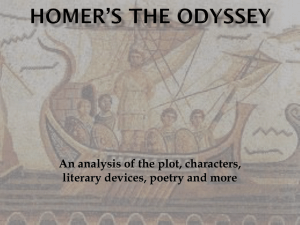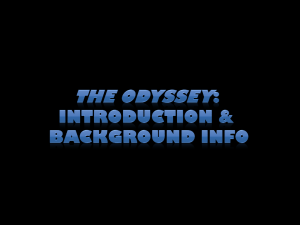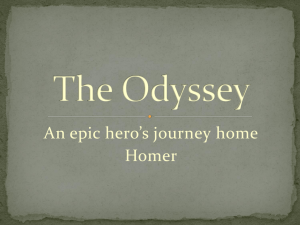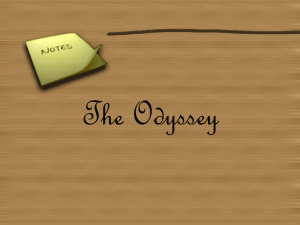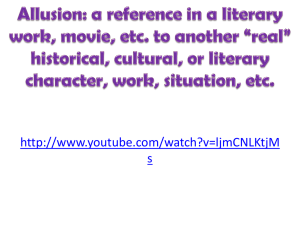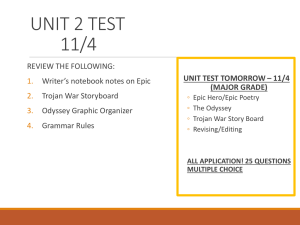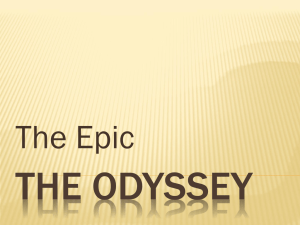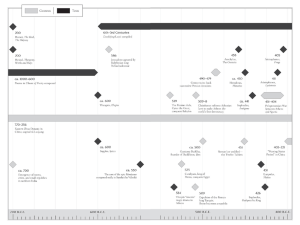The Odyssey background info
advertisement
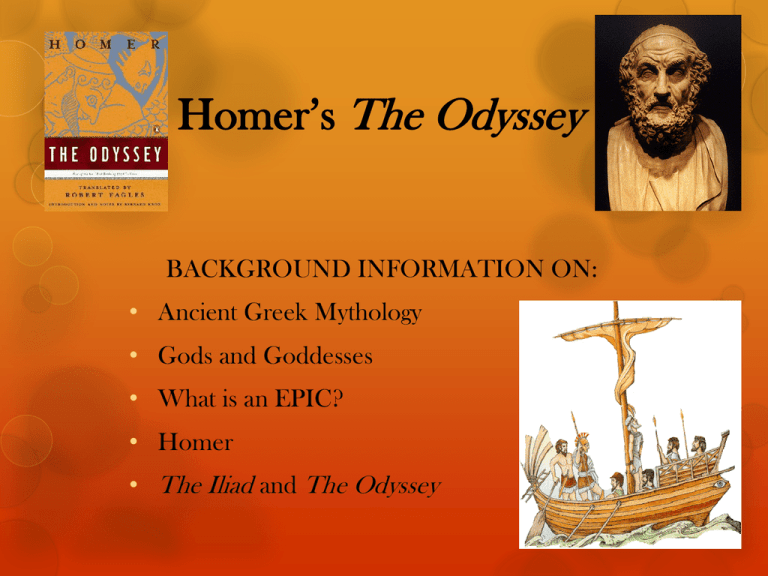
Homer’s The Odyssey BACKGROUND INFORMATION ON: • Ancient Greek Mythology • Gods and Goddesses • What is an EPIC? • Homer • The Iliad and The Odyssey What is MYTHOLOGY? Mythology is the study of myths, or stories that symbolize basic truths about life. Myths are usually passed down orally through many generations. Usually myths involve extraordinary or supernatural beings and events. They have been one of the biggest sources of inspiration for literature, drama, and art throughout the world. There are as many kinds of myths as there are situations affecting mankind. Most deal with cosmological events or with moments of crisis in the human life cycle. Others try to make sense of important historical events or explain the existence of extraordinary beings. What are some myths that you’re familiar with? GREEK & ROMAN MYTHOLOGY: GODS & GODDESSES GOD/GODDESS GREEK NAME ROMAN NAME Sky God, Ruler Zeus Jupiter (Jove) Queen Hera Juno Sun, Light Apollo Apollo Moon Artemis Diana War, Storms, Thunder Ares Mars Sea, Rivers, Oceans, Rain Poseidon Neptune Agriculture, Fertility Demeter/Persephone Ceres/Proserpine Fertility, Wine, Drama Dionysus Bacchus Love Aphrodite/Eros Venus/Cupid Underworld, Dead Hades Pluto Wisdom, Knowledge Athena (female) & Apollo (male) Minerva Crafts, Invention Hephaestus/Athena Vulcan/Minerva Messenger Hermes Mercury All Greek/Roman gods and goddesses lived on MOUNT OLYMPUS! There are many, many mythological references in The Odyssey. Gods/Goddesses in The Odyssey ZEUS Zeus is the king of gods. He lived on Mount Olympus with his wife, Hera. He was the most powerful god and ruled both Heaven and Earth. He controlled the sun and the moon, as well as the seasons. Zeus is known for his “erotic escapades,” so he had children who were gods (from Hera) and heroes/mortals (from nymphs and other women). When angered, he hurled thunderbolts down to Earth. His symbols are a thunderbolt, an eagle, a bull, and an oak tree. Gods/Goddesses in The Odyssey POSEIDON Poseidon was the ruler of the sea (and earthquakes), second in power only to his brother Zeus. He unleashed the fury of the sea on those who angered him. His palace was at the bottom of the sea, but he went to Mount Olympus whenever he wished. Like Zeus, he had many children, one of whom (Polyphemus) plays a major role in The Odyssey. His symbol of power was a trident, a three-pronged spear. Other symbols are a fish, a dolphin, and a bull. He is often depicted riding a chariot over a smooth sea. Gods/Goddesses in The Odyssey ATHENA Athena was the goddess of warfare (and civilization, wisdom, strength, strategy, crafts, justice and skill). However, she fought only when she had to, and preferred wisdom and peace over war. She only fought for a reasonable cause or to defend the forces of good. She was Zeus’ favorite son/daughter, and is said to have sprang fully-grown from the head of Zeus holding a spear. Because she was so wise, Athena appears in Greek mythology as the patron and helper of many heroes, including Odysseus. The Greeks built the Parthenon in Athens in her honor. Her symbols include an owl, an olive tree, armor, and a spear. Gods/Goddesses in The Odyssey HADES Hades was the ruler of the Underworld. He was the god of the dead and wealth. He was the older brother of Zeus and Poseidon. The three brothers claimed rule over the cosmos: the Underworld, the sea, and the air. All three ruled land together. The gate to the Underworld was guarded by Cerberus, the threeheaded dog. Before entering the Underworld, the dead were ferried across the River Styx. His symbols are Cerberus and the Cap of Invisibility. Gods/Goddesses in The Odyssey HERMES Hermes was the messenger for all gods on Olympus, particularly his father, Zeus. He wore wings on his helmet and sandals. He could fly freely between the mortal and immortal world, and was responsible for watching over travellers and leading the dead to the Underworld. Hermes was believed to have invented many types of racing and the sports of wrestling and boxing, and therefore was a patron of athletes. His symbols include the tortoise, the rooster, winged sandals, a winged hat, and the caduceus (wand decorated with snakes). What is an EPIC? Epics are often of national significance, so they define the history and social values of a nation. The most common kind of epic – the oral epic – was first spoken and then recorded onto paper. All epics have several features in common: A central figure who is heroic or super human (Odysseus in The Odyssey) Long, arduous, perilous journeys Various mistakes and misadventures Strong supernatural or otherworldly elements (gods, goddesses, etc.) Long passages of narrative dialogue Vivid descriptions Departure from the task at hand Larger-than-life scenarios Portray the goals and values of a society (in this case, ancient Greece) The Elements of an EPIC EPIC HERO – The central figure of an epic, a figure of high social status and great strength. His importance is national, even universal. The epic hero embodies the traits that are the most valued by the society the epic comes from. The epic hero is called an archetype, a figure who represents the most admirable traits a human can possess. EPIC SIMILE – A long, complex comparison using “like” or “as.” HOMERIC EPITHET – Homer often joins adjectives to make compound adjectives. They are used repeatedly to characterize or describe someone or something. Example: “God-like Odysseus” INVOCATION – An appeal for help or inspiration from a god/goddess or muse. An invocation appears in ALL epics, and it comes at the very BEGINNING. Early on, the poet asks the epic question; the rest of the story answers this question. Where is the invocation in The Odyssey? HOMER (No, not Homer Simpson…) Most famous of ALL Greek epic poets; lived in 9th century B.C. A blind, nomadic, wandering poet Possibly born in Iona, which is on the west coast of present-day Turkey His best-known works are The Iliad and The Odyssey, which both deal with the defining moment of Greek culture – the TROJAN WAR. His epics made up the basis of education in ancient Greece; also influenced Roman and Christian values and educational ideals. His two epics are the highest cultural achievement of the Greek people; they define Greek culture and set the Greek ideals in stone. Homer’s Major Works: THE ILIAD The Iliad is the story of a brief event in the ninth year of the Trojan War (which lasted ten years); the great hero ACHILLES is offended when the leader of the Greeks, Agamemnon, takes a slave girl Achilles has been awarded. Achilles withdraws from the battle and prays to his mother (Thetis, a goddess) to turn the tide of the battle against the Greeks. The gods grant Achilles his prayer, and he does not return to battle until his best friend is killed by the great Trojan hero, Hector. Achilles throws himself into the battle, fights Hector, and kills him. In a final gesture of contempt, he drags Hector’s lifeless body around the walls of Troy. The main theme of the epic is “Achilles’ choice.” Achilles has been offered a choice: either he can be a great and famous hero in war and die young (he eventually does die in Troy when he is struck by a poisoned arrow in the heel), or he can live a long, happy life without any lasting fame at all. Although Achilles initially chooses not to die young, the death of his friend forces him to make the choice to be famous for all time, but tragically dead at a young age. Homer’s Major Works: THE ODYSSEY The Odyssey is the story of the homecoming of another Greek hero at Troy, Odysseus. Unlike Achilles, Odysseus is not famous for his strength and bravery, but for his ability to deceive and trick others (it is supposedly Odysseus’ idea to take Troy by offering the enemies a great wooden horse full of Greek soldiers). After the war, Odysseus is in such a rush to get home to Ithaca (where his wife and child await) that he fails to make a proper sacrifice to the gods. His homecoming is delayed for ten years because of the anger of the gods; finally, ten years after the end of the war, he is allowed to return home. For most of the ten years he has been living on an island with the goddess Calypso, who is madly in love with him. Odysseus, like Achilles, is offered a choice: he may either live on the island with Calypso and be immortal like the gods, or he may return to his wife and his country and be a mortal like the rest of us. He chooses to return, and much of the rest of the work is a long exposition on what it means to be “mortal.” The main theme of The Odyssey is the nature of mortal life, and why any human being would (if offered the chance to become a god) still choose to be mortal. Much of the epic deals with the aura surrounding death, the nature of human civilization, and human savagery. The SETTING of The Odyssey TIME: After the Trojan War – 13th or 12th century B.C. PLACE: Mediterranean Sea The Beginning… (In Media Res = In the middle of the action) We start out The Odyssey with Telemachus (Odysseus's son) looking for Odysseus. Telemachus was just a newborn when his father left to fight in the Trojan War. We know that the war lasted 10 years, and that Odysseus was detained by the gods for 10 years, so Telemachus is now 20 years old. So where is Odysseus? Lost? Dead? Alive? To make matters worse for Telemachus, nobody but his mom (Penelope) and he believes that Odysseus is still alive. All the losers in Ithaca (Odysseus's home) want Penelope to marry one of them so that there can be a king again. Telemachus leaves to go find his dad, without any help from other men in Ithaca. Meanwhile, Odysseus washes ashore in a strange place. He is taken to the king of that land. Odysseus then begins to tell the king his story of where he has been the last ten years... What’s Next? Next class, you will have an open-note quiz about ALL of today’s background information, as well as the Trojan War reading assignment. We will also be watching excerpts from the movie Troy if everyone gets their permission slip signed.
